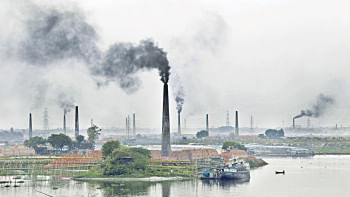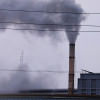A much-needed step in curbing air pollution

We appreciate the initiative taken by four South Asian countries – Bangladesh, India, Nepal and Pakistan – to bring down their annual average of particulate matter (PM) 2.5 to 35 microgrammes per cubic metre by 2030, following a suggestion by the World Health Organization to reduce air pollution. At a time when Bangladesh is seriously struggling to contain air pollution in its major cities, particularly the capital, such a collaborative approach seems to be a step in the right direction. According to the roadmap forged by the four countries, there will be both national and regional steps aimed at improving the quality of air.
PM 2.5 consists of dust and other matters generally smaller than 2.5 micrometres, and is considered most hazardous to human health. Worryingly, the annual average PM 2.5 in Bangladesh is around 85 to 90 microgrammes (mcg) per cubic metre, which can be severely hazardous. Even a PM 2.5 level of 35 mcg/cubic metre or above in a 24-hour period is considered unhealthy. It can cause problems for people with breathing issues such as asthma. Thus, bringing down the PM 2.5 level is crucial to contain air-related health issues.
So far, local authorities have been unable to reduce air pollution largely because the issue has not received the attention necessary for a desired change. Clearly, despite written commitments and official edicts, there has been a lack of interest at the highest level. In the absence of necessary measures, Dhaka city was ranked the second-most polluted city in the world from 2018 to 2021. It is also shocking that High Court directives given in this regard have hardly had any impact. While Dhaka's construction sites and persistent traffic jams have been major sources of PM 2.5, the brick kilns are another big source, which are still operating illegally across the country.
And while we have been talking about only the national-level pollution sources, of which there are many more, a recently published report of the World Bank has identified a rather unusual source of pollution. It has revealed that under the predominant wind direction from the northwest to the southeast, 30 percent of the air pollution in the three largest cities of Bangladesh – Dhaka, Chattogram, and Khulna – originates in India. Therefore, only taking national-level measures will not be enough to reduce the PM 2.5 level; for a bigger impact, it will need coordinated regional policies and activities.
According to the World Bank, air pollution is killing around 80,000 people every year in Bangladesh, and is wiping out around 4 percent of the country's GDP. What's stopping us from taking meaningful action to prevent this? This, certainly, cannot continue. We must remove the biggest sources of pollution inside the country quickly. Working with our regional partners to stop transboundary pollution is also a priority. We urge the authorities to take the regional roadmap seriously and take steps to maximise its impact as soon as possible.


 For all latest news, follow The Daily Star's Google News channel.
For all latest news, follow The Daily Star's Google News channel. 








Comments